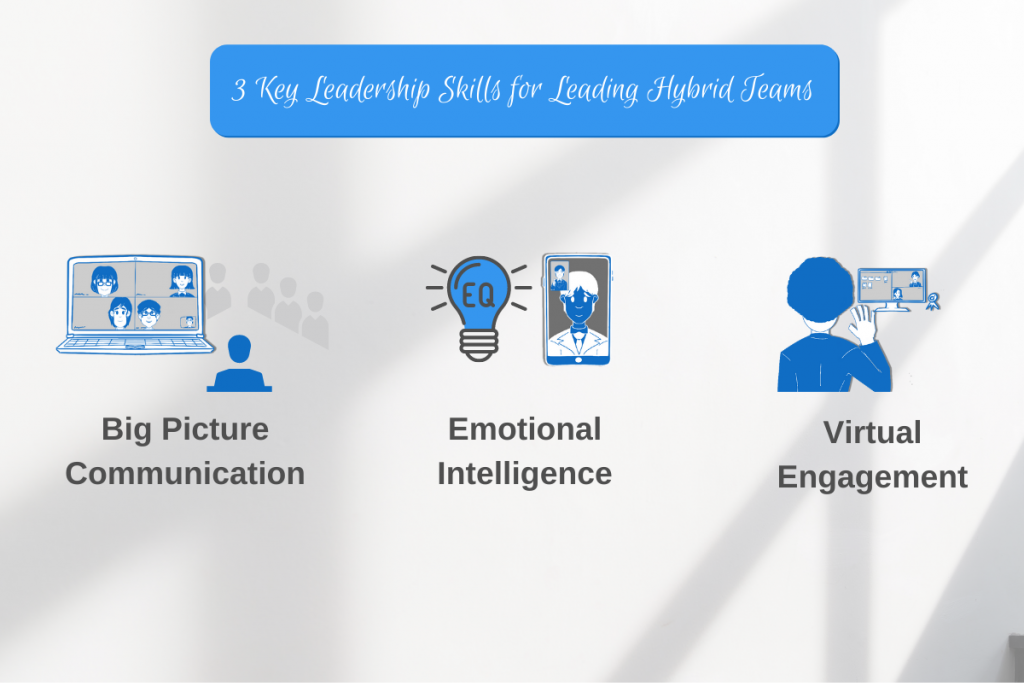Are the skills for leading a hybrid team or a remote team any different to that of leading teams in your office environment? Behaviours are difficult to change. You have spent most of your career working in an office environment. Seeing who is in the office and being able to walk over to them to ask for updates on projects is something you’re used to. You may bump into them on your way to the kitchen for a cup of tea. Or able to pick up on bits and pieces from overhearing conversations. You will also be able to pick up on the mood of the team. You were confident with how to lead your team.
Pre Covid-19 pandemic and lockdown, working from home was a privilege. Allowing your team members to work from home, except for emergencies were out of the question. For most organisations, this privilege was reserved for the leadership and senior management teams along with a trusted few. Yet, the pandemic and lockdown forced employees in all manner of roles to work remotely.
Organisational leaders had to adapt their leadership style to lead remote teams. Through the various phases of mandatory and advisory work from home, work from home if you can, remote workforces have performed their respective roles. They have supported their businesses to thrive through the pandemic and the lockdown. Every situation presents opportunities as well as challenges. A lot of organisations have evaluated and have and are making a shift towards hybrid working. Household names such as Twitter and Spotify have already moved towards hybrid working. Some organisations are making the bold move into becoming 100% remote. Most start-ups are embracing 100% remote.
Here are three key skills you need to lead a productive hybrid team.
Leading a Hybrid Team – Big Picture Communication
Depending on your working arrangements for your hybrid teams, you may see more of a particular group of people than others. It is important to remember at all times that you are a leader for all, not a few. So your hybrid working arrangements should allow you to see people across your teams and not a particular group.
Communication with your entire team is necessary and key to whether you succeed or fail. Working remotely does not need to lead to the isolation of team members.
The bigger picture in this sense will have two meanings for you. The first is ensuring that you communicate the big picture to your entire organisation or team. You need to do so in a clear and concise way. Do not leave room for misinterpretation and ambiguity. Allow your team to ask questions and provide answers to their questions. The second is whether you still have the bigger picture as a leader. Do you know what is going on in every part of your organisation or with your team? What measures have you put in place to ensure that your teams are still able to communicate their progress with you?
You can use a regular reporting mechanism as a tool to get insights into all areas of your organisation. The report must be meaningful and concise but also provide you with a true picture of what is going on. You can develop a template for your team to follow to write such reports. Have daily, weekly or monthly progress catchups for teams to update you. You may also be able to deploy technologies that will give you and your team visibility in real-time through a dashboard. You must communicate any measures you put in place to your team. Ensure that they understand the purpose, how and when to use tools that you have provided for them.
You need to create an environment that encourages open and honest communication. Two-way feedback between leadership and the workforce will help both you and your workforce to understand what is working well and what is not.
Emotional Intelligence for Leading a Hybrid Team
Understanding your own emotions puts you in a better position to understand others. Tapping into your emotional intelligence will be useful in motivating your team. You will also be able to influence and inspire your team. You will be able to show empathy when it is needed and will come across as more authentic and trusting to your team.
Trust is a key ingredient to successfully leading remote and hybrid teams. You need to be able to trust your team and they will need to trust you. You will have to develop a strong interpersonal relationship with your team. In a pure remote working environment, you may be working with someone for a long time before you meet them physically in person. Applying your emotional intelligence to how people present themselves on camera versus what they may actually be feeling or going through may help you connect to your team. You will be able to understand if someone is doing okay or if they are struggling. If there is a sudden drop in performance or engagement, you may be able to spot this much quicker. You will also be able to offer the support your teams need to succeed.
Virtual Engagement Necessary when Leading a Hybrid Team
Engaging with your remote working employees shouldn’t have to be tasking. You should be checking in on your employees working remotely on a regular basis. When you are working in the office, you often move around. You are rarely sat at your desk for more than two hours without a break. It is recommended that you take regular short breaks away from the display screen equipment. You can shape the culture of your organisation to create a healthy virtual working environment where your employees feel enabled to take breaks when they need them.
Have you developed a plan for hybrid working and communicated this to your team? Are your team members aware of how they are expected to engage with you and the rest of the team? Are you ensuring that everyone gets invited to meetings that they are expected to attend? Do your virtual employees need to engage with customers? Have they been trained to engage in a professional manner and in line with your brand?
Do you find it easy or difficult to engage with your remote teams? Are you struggling to inspire and motivate them the same way as you would if they were in the office?
Role of Technology in Virtual Engagement
Technology plays a major role in virtual engagement. Do your employees have the necessary equipment to facilitate working from home? This includes good IT equipment, software, secure networks, fast broadband speeds, suitable desks and working environments. Do they have the right training to be able to use the equipment and to do their job? If you are using any monitoring tools, ensure that you make your team aware.
Health and Safety
You have a duty to protect the health, safety and welfare of your employees. You must take measures that are reasonably practicable to fulfil this duty. Practical steps may include providing training for your employees to be able to do their jobs. You must also ensure that they are competent to use the equipment you have provided for their job. These include IT equipment and software. You must also make sure that your employees have risk assessed their home working environments. Ask them to provide you with a copy of the completed risk assessments for your records.
Check that your insurance policy covers your employees working from their homes. You must communicate to your employees what they may be covered for under your insurance policy. Encourage your employees to check with their home insurers what they may or may not be covered for.
You must encourage your teams to take regular short breaks from their workstations. You can make available to them short training exercises and videos to help them avoid work-related musculoskeletal disorders. As a responsible leader, you must also put plans in place for the well-being of your teams. You can put in place employee assistance programmes for your workforce. This will provide more support for your employees on top of what you are already doing for them in your workplace.
Do I have to?
Hybrid working is here to stay. A lot of employees have tasted the benefits of having a good work-life balance. Not having to spend hours commuting to their places of work means that you get to spend quality time with your family. Some employees are willing to take a pay cut in return for the flexibility to work remotely or for hybrid working. To be able to attract and retain top talent in the future, organisations may not have a choice but to offer flexible, hybrid or remote working. Leaders need to have the right skills and approach to leading remote and hybrid teams.



